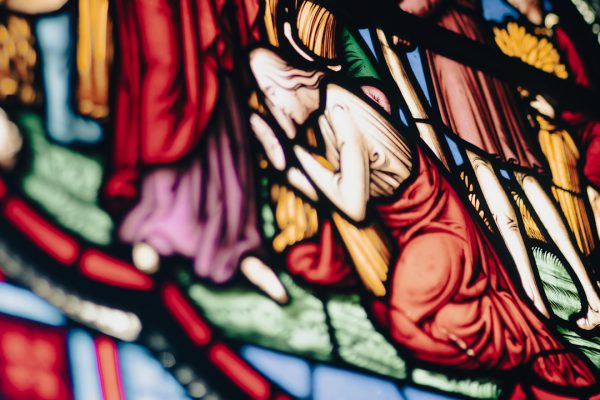One of the most famous stories in the Bible is Noah and the Ark. Because we are so familiar with this story, and the difficult questions it often raises, we can miss how it is connected to the larger story of Scripture, how it points to Jesus, and what it means for us today. When we consider this story in its canonical context we will see that, just as the ark provided safety from the waters of judgment, God now provides salvation from the Day of Judgment through Jesus Christ. And Scripture tells us that this good news is pictured and proclaimed in baptism.
Noah and the Ark: Salvation Through Judgment
In Genesis 6 we learn that Noah was a righteous man who walked with God (Gen. 6:8-9). The rest of the earth, however, was corrupt, filled with violence, and their thoughts were only evil continually (Gen. 6:5, 11-13). So God instructed Noah to build an ark, because he would bring a “flood of waters upon the earth to destroy all flesh,” and he promised to establish a covenant with Noah (6:17-18)
Then in Genesis 8:1 we have the turning point in the story: “But God Remembered Noah.” This contrasts the destruction of the world for its sin and the deliverance of Noah and those with him in the ark. Up until this point the story has been about de-creation; water covered the earth just as at creation. But everything after this verse is about re-creation; it’s about God bringing life from the chaotic waters of death. Just like the Spirit hovered over the waters at creation, God sent a wind to drive the waters away and a dove was sent out over the waters after the flood. And Noah and his family stepped out onto new creation ground, because of their faith in God’s promise of salvation.
A Pattern in Scripture
This story teaches us several things about how God acts that are important for understanding the Bible. It highlights God’s sovereignty over his creation and his just judgment on sin; it shows us God’s mercy and grace for towards those who trust him; and it shows us the proper response of trust and obedience in God’s plan and his salvation.
But it also shows us that God’s glory is seen in salvation through judgment. Noah was saved and kept safe through the judgment on the sinful world. The water which brought judgment on mankind is the very water which saves Noah and those with him in the ark. And this is a recurring theme throughout Scripture:
- When Pharaoh kills the Hebrew baby boys by throwing them into the Nile river, Moses is put in a basket (literally, an “ark”!) and is saved by the waters from the waters of death. He is given the name Moses because he was drawn up out of the water.
- Then there is the exodus, where God’s people were kept safe as they passed through the waters of the Red Sea. The very waters that provided safety for them judged their enemies. In fact, Paul, in 1 Cor. 10 says that all Israel passed through the sea and were baptized into Moses, because they followed him like Noah’s family joined him in the boat. The waters they passed through brought them from slavery into freedom and a new covenant with Yahweh. Out of these waters of judgment, God made a new creation with Israel.
Fulfilled in Jesus and his Baptism into Death
But most importantly, this story points to and is fulfilled in Jesus. Jesus was the perfectly righteous One in the midst of a wicked generation who passed through the waters of death and was drawn out of those waters in resurrection power. He has made possible a new covenant and a new creation since he triumphed over sin once for all.
In Mk. 10:38 and Lk 12:50 Jesus speaks about his death on the cross as a baptism, because suffering and judgment are often described in Scripture as an overwhelming flood (Pss 18:16; 42:7; 69:1–2; Isa 43:2). Jesus’ death was a baptism because he suffered the judgment for sin, taking the flood of judgment entirely on himself so that we could find refuge in him and in the blood of his cross. And God brought salvation through judgment by raising Jesus from the dead. His cross now becomes the ark that we find refuge in, and all who are with Jesus, like Noah’s family were with him, will be saved from the judgment their sin deserves.
But this story isn’t just something that happened way back then; it’s not just something to trace through the Bible. This good news is for our world today. And for those who have come to believe in Jesus, this is our story, because this is what the ordinance of baptism is about.
Baptism Into Christ: From Death to Life
Peter writes in 1 Peter 3:20-22 that Noah and his those with him were brought safely through water, which literally is “saved through water”: they were saved by the water, from the water. Then he says in verse 21 he says “Baptism, which corresponds to this, now saves you, not as a removal of dirt from the body but as an appeal to God for a good conscience, through the resurrection of Jesus Christ.” The flood waters point to, correspond to are a prefigure of the waters of baptism. Eugene Peterson’s paraphrase is helpful here: “The waters of baptism do that for you, not by washing away dirt from your skin but by presenting you through Jesus’ resurrection before God with a clear conscience” (The Message).
Just as Noah was saved through the judgment of the flood, those baptized into Christ, by faith in his name, are saved through the flood of God’s wrath that fell on Jesus. Like Noah, we are rescued from the present evil age and brought safely to a new creation. Like Israel, we are brought through the waters into a new kingdom, the kingdom of the Son, with our sins washed away, sunk to the bottom of the sea. We aren’t saved because water is magical, but because of the resurrection of Jesus Christ. Baptism is how we call on the name of the risen Lord Jesus to be saved. This corresponds with what Paul says in Romans:
We were buried therefore with him by baptism into death, in order that, just as Christ was raised from the dead by the glory of the Father, we too might walk in newness of life (Romans 6:4).
Dying to the World
In baptism we are saying to the world, “We need to die. We need our sins washed away. We need to be cleansed and purified.” It announces to the world that there is a judgment for sin that is coming, and the only solution is to be found in Christ, dying with him, trusting in his death and resurrection.
In baptism, we don’t die with the world; we die to the world. Our old temptations, habits, former allegiances and relationships, all of those die. And we are reborn as part of the new creation. It announces to the world that the kingdom of God has come. It’s a sign of the resurrection power of the new creation breaking into our world. It’s a big neon sign that says to the world, “This person is in Christ is a new creation!” And if anyone is in Christ, and is a new Creation, they are now part of Christ’s body and filled with his life-giving Spirit.
The Doorway Into Membership in the Church
Baptism is how a person goes public with their faith. It’s a sign and seal that indicates this person belongs to God and is a member of Christ’s body. It tells us who we are and whose we are. It tells us what kingdom we are a part of and what Lord we serve. It’s a public way of showing that they have been transferred from the kingdom of darkness to the kingdom of the beloved Son (Col. 1:13-14).
In other words, baptism is the doorway into membership in Christ’s church. It’s not only an “outward” sign of some mystical inward reality; it’s also an “outward” sign of becoming part of a local church. Just like a new creation followed the flood, and a new people were formed after the Red Sea, the new creation that follows baptism is the church. Peter Leithart says it well:
Baptism is the doorway into membership in the church…Baptism is powerful because it places us in the church where pastors, friends, and mentors train us and pray for us—where God corrects and feeds us by his word at his table. Baptism does what it does because Jesus authorizes it. Baptism works because the church works, and the church works because it’s the body of Christ, enlivened by the Spirit.
If the church is what the New Testament says it is and if baptism is the doorway to the church, then certain things necessarily follow: baptism is adoption into the Father’s family, union with Christ in his body, installation as a living stone in the temple of the Spirit. If the church is what the New Testament claims, baptism gives us a share in the resurrection life of the Son and his Spirit. If the church is as the New Testament describes it, baptism is the gift of a future, propelling us toward the unending joys of a new heaven and a new earth. It is indeed a “saving flood.”
Peter Leithart, Baptism: A Guide to Life from Death (Lexham Press: Bellingham, WA, 2021), 7.
So for those who have been baptized into the family of God, the body of Christ, the temple of the Holy Spirit:
- Consider yourselves dead to sin and alive to God in Christ. Believe what your baptism is telling and showing you. Make that the controlling factor of your life: You have been crucified with Christ, and you have claimed by him and raised with him in newness of life.
- Remember that baptism is a promise of God’s forgiveness. This is the day you can say you died to the old world. Don’t abandon the ark and make shipwreck of your faith.
- Remember your baptism, what God has done for you. Remember that you have died, and your life is hidden with Christ in God, and when Christ appears, you will appear with him in glory (Col 3:3-4)
Recommended Reading
- Going Public: Why Baptism Is Required for Church Membership, Bobby Jamieson.
- “What’s in the Water?: Baptism as a Sign of Addition”, Trent Hunter
- “Youth and Church Membership—Or, Stop Baptizing Children into the Ether“, Alex Duke

Mitch Bedzyk serves as a pastor Emmanuel Community Church, overseeing music and Sunday Classes. He received his Master of Theological Studies from Midwestern Baptist Theological Seminary and works in IT for the NY Office of Mental Health. He and his wife, Sarah, have five children: Kya, Khalli, Oliver, Amelia, and Micah. In his spare time he enjoys reading, coffee, guitar, playing fantasy soccer and fanatically following Major League Soccer and the German Bundesliga




